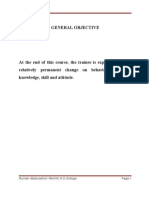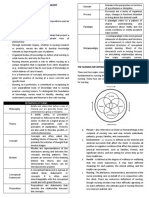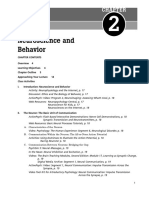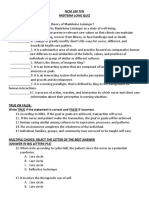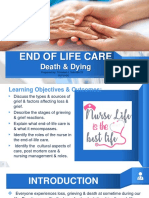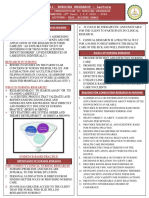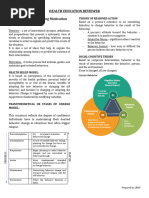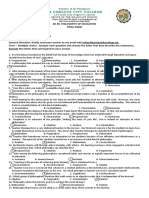Intro To Nursing Theory and History Philosophy of Science
Uploaded by
jacie 101Intro To Nursing Theory and History Philosophy of Science
Uploaded by
jacie 101Introduction to Nursing Theory
History of Nursing Theory
1. The history of professional nursing began with Florence Nightingale.
2. Nightingale is considered to be the first nursing theorist
3. The curriculum era addressed the question of what content nurses should study to learn
how to be a nurse.
4. In the research era, nurses increasingly sought degrees in higher education and began to
participate in research.
5. The research era and the graduate education era developed in tandem. Master’s degree
programs in nursing emerged across the country to meet the public need for nurses for
specialized clinical nursing practice.
6. In the theory era, understanding of research and knowledge development increased, it
became obvious that research without conceptual and theoretical frameworks produced
isolated information. Rather, there was an understanding that research and theory
together were required to produce nursing science.
7. The theory utilization era has restored a balance between research and practice for
knowledge development in the discipline of nursing.
Significance of Nursing Theory
At the beginning of the twentieth century, nursing was not recognized as an academic discipline
or a profession. How does nursing theories helped nursing to be recognized as a discipline and
as a profession?
Before we identify its significance, let us differentiate discipline and profession. A discipline is
specific to academia and refers to a branch of education, a department of learning, or a domain
of knowledge. A profession refers to a specialized field of practice, founded upon the theoretical
structure of the science or knowledge of that discipline and accompanying practice abilities.
Nursing is a professional discipline, a field of study, focused on human health and healing
through caring (Smith, 1994). The knowledge base of the discipline consists of diverse
components such as nursing science, art, philosophy, and ethics. Nursing science comprises the
conceptual models, theories, and research findings specific to the discipline. As in other sciences
such as biology, psychology, or sociology, the study of nursing science requires a disciplined
approach.
Significance for the Discipline
1. Development of knowledge and nursing science as a basis for nursing practice
2. Organize curricula in nursing programs
Significance for the Profession
1. Theory-based evidence for practice is beneficial to patients in that it guides systematic,
knowledgeable care.
2. Tool for the reasoning, critical thinking, and decision making required for quality nursing
practice
History and Philosophy of Science
“Why should nurses be interested in the history and philosophy of science? The history and philosophy
of science is important as a foundation for exploring whether scientific results are actually
truth. As nurses our practice should be based upon truth and we need the ability to interpret the
results of science. Nursing science provides us with knowledge to describe, explain and predict
outcomes. The legitimacy of any profession is built on its ability to generate and apply theory.”
(McCrae, 2011, p. 222)
The development of nursing science has evolved since the 1960s
Being a scientific discipline means identifying nursing’s unique contribution to the care
of patients, families, and communities.
Epistemology is concerned with the theory of knowledge in philosophical inquiry.
Two competing philosophical foundations of science – rationalism
Rationalism
Rationalist epistemology (scope of knowledge) emphasizes the importance of a priori reasoning
as the appropriate method for advancing knowledge. A priori reasoning utilizes deductive logic
by reasoning from the cause to an effect or from a generalization to a particular instance.
Reynolds (1971) labeled this approach the theory-then-research strategy.
An example in nursing is to reason that a lack of social support (cause) will result in hospital
readmission (effect). In rationalist point of view, you can never prove that all individuals without
social support have frequent rehospitalizations since there might be one individual that presents
with no rehospitalization.
Empiricism
The empiricist view is based on the central idea that scientific knowledge can be derived only
from sensory experience (i.e., seeing, feeling, hearing facts). This approach, called the inductive
method, is based on the idea that the collection of facts precedes attempts to formulate
generalizations, or as Reynolds (1971) called it, the research-then-theory strategy. Empiricists
view phenomena objectively, collect data, and analyze it to inductively proposed theory (Brown,
1977).
Example: “An elderly patient has been in a trauma and appears to be crying. The nurse on
admission observes that the patient has marks on her body and believes that she has been abused;
the orthopedist has viewed an x-ray and believes that the crying patient is in pain due to a
fractured femur that will not require surgery only a closed reduction; the chaplain observes the
patient crying and believes the patient needs spiritual support. Each observation is concept laden.”
You might also like
- A Modern Introduction To Madhva Philosophy-B .H. Kotabagi100% (2)A Modern Introduction To Madhva Philosophy-B .H. Kotabagi350 pages
- 1 Theoretical Foundations of Nursing UpadatedNo ratings yet1 Theoretical Foundations of Nursing Upadated17 pages
- Physiological Aging: Artizuela, Marisol O'Dell, Andrea Romero, Erra Lee Sese, Kameron Gayla Pangilinan, Kenneth ChristianNo ratings yetPhysiological Aging: Artizuela, Marisol O'Dell, Andrea Romero, Erra Lee Sese, Kameron Gayla Pangilinan, Kenneth Christian12 pages
- Philippine Health Agenda - Dec1 - 1 PDFNo ratings yetPhilippine Health Agenda - Dec1 - 1 PDF26 pages
- Review of Ten (10) R'S of Drug AdministrationNo ratings yetReview of Ten (10) R'S of Drug Administration11 pages
- Protein: Proteins: The Body's Building BlocksNo ratings yetProtein: Proteins: The Body's Building Blocks6 pages
- FU-M1-CU5 LEC Nursing Diagnosis - Utilizing Nurse's Reasoning ProcessNo ratings yetFU-M1-CU5 LEC Nursing Diagnosis - Utilizing Nurse's Reasoning Process9 pages
- Theoretica L Foundatio NOF Nursing: Ma - Alicia Grace S. Kaimo, RN, ManNo ratings yetTheoretica L Foundatio NOF Nursing: Ma - Alicia Grace S. Kaimo, RN, Man18 pages
- Fundamentals of Nursing Practice (Theory) - Module 2 - CommunicationNo ratings yetFundamentals of Nursing Practice (Theory) - Module 2 - Communication16 pages
- Syllabus - NRS 500 Foundation of NursingNo ratings yetSyllabus - NRS 500 Foundation of Nursing4 pages
- Course Syllabus Health Assessment LatestNo ratings yetCourse Syllabus Health Assessment Latest6 pages
- 2 Introduction To Nursing Theory HandoutNo ratings yet2 Introduction To Nursing Theory Handout4 pages
- FUNDA HAND-OUT - Nursing As A ProfessionNo ratings yetFUNDA HAND-OUT - Nursing As A Profession7 pages
- Lesson 5 - Planning For Health Promotion and MaintenanceNo ratings yetLesson 5 - Planning For Health Promotion and Maintenance40 pages
- Nursing Process: Claudette Mcgregor-Coombs, MSN, ArnpNo ratings yetNursing Process: Claudette Mcgregor-Coombs, MSN, Arnp63 pages
- Biological Basis For Behavior ResourcesNo ratings yetBiological Basis For Behavior Resources34 pages
- Nursing Process Approach-Identification of Health Illness, Health Behaviour, Sign and Symptoms of CleintNo ratings yetNursing Process Approach-Identification of Health Illness, Health Behaviour, Sign and Symptoms of Cleint27 pages
- NCM116 Finals Assessment of The Nervous SystemNo ratings yetNCM116 Finals Assessment of The Nervous System9 pages
- Theoretical Foundations of Nursing Practice100% (1)Theoretical Foundations of Nursing Practice81 pages
- MODULE 8 - Gender and Development in Nation BuildingNo ratings yetMODULE 8 - Gender and Development in Nation Building23 pages
- 03 - HA - Assessment of The Head, Face, Neck, and LymphaticsNo ratings yet03 - HA - Assessment of The Head, Face, Neck, and Lymphatics2 pages
- Understanding Political Theory: BPSC-101No ratings yetUnderstanding Political Theory: BPSC-10135 pages
- Brown - Analyticity - An Ockhamist ApproachNo ratings yetBrown - Analyticity - An Ockhamist Approach16 pages
- Marchi The Popperian Legacy in EconomicsNo ratings yetMarchi The Popperian Legacy in Economics292 pages
- Emile Durkheim'in Pragmati̇zm Üzerine Fi̇ki̇rleri̇No ratings yetEmile Durkheim'in Pragmati̇zm Üzerine Fi̇ki̇rleri̇304 pages
- Epistemological Dualism Vs Metaphysical DualismNo ratings yetEpistemological Dualism Vs Metaphysical Dualism13 pages
- Artificial Intelligence - Literature ReviewNo ratings yetArtificial Intelligence - Literature Review54 pages
- Research Methods for Leisure and Tourism 5th edition Edition Anthony James Veal - eBook PDFinstant download100% (2)Research Methods for Leisure and Tourism 5th edition Edition Anthony James Veal - eBook PDFinstant download52 pages
- EDUC-96-Philosophy-of-Education-Final-Exam (Jeanicar Aninon)100% (1)EDUC-96-Philosophy-of-Education-Final-Exam (Jeanicar Aninon)5 pages
- Book Review Creswell, J. W. (2014) - Research Design: Qualitative, Quantitative and Mixed Methods Approaches (4th Ed.) - Thousand Oaks, CA: SageNo ratings yetBook Review Creswell, J. W. (2014) - Research Design: Qualitative, Quantitative and Mixed Methods Approaches (4th Ed.) - Thousand Oaks, CA: Sage2 pages
- Syllabus FOR B.A. (Hons.) PHILOSOPHY Berhampur UniversityNo ratings yetSyllabus FOR B.A. (Hons.) PHILOSOPHY Berhampur University20 pages
- Practical Research 2: Schools Division of Bohol: 4: 7: 70% (1)Practical Research 2: Schools Division of Bohol: 4: 7: 72 pages
- Z-Test For Large Samples: Dr. Rajesh MoharanaNo ratings yetZ-Test For Large Samples: Dr. Rajesh Moharana24 pages
- Kitchenham - Systematic Literature Reviews in Software Engineering - 2009No ratings yetKitchenham - Systematic Literature Reviews in Software Engineering - 20099 pages






